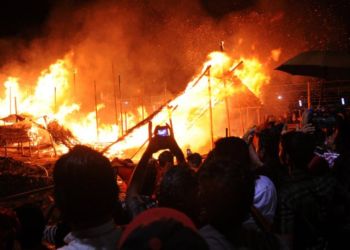12-day ‘Athirathram’ comes to an end

Twelve days of ‘chanting of mantras’ and ‘performing homam’ at the panoramic village of Panjal, near Shoranur, came to an end on Friday night.
At the end of ‘Athirathram’, an ancient Vedic ritual that is considered to be the ultimate invocation of scriptures, the Yajamanan (Puthillathu Ramanujan Akkithiripad) and Yajamanapathni (Dhanyapathanaadi) of the ritual ceremonially left the Yagashala carrying the fire from the altar to their house, where they would keep it burning.
As thousands of people watched, the Yagashala in the vicinity of Panjal Lakshmi Narayana temple was ceremonially set on fire at 10 p.m. marking the conclusion of the 12-day ritual.
Those present at the venue claimed that a ‘garuda’ (eagle) was seen flying over the ‘Yagasala’ early in the day, which experts claimed a good omen.
Heavy rain that fell over the area delayed the final rituals for sometime. By letting members of various castes and communities to witness the Vedic rites, the Athiratram is said to have reflected the spirit of the changing times in Kerala.
Lakhs of people witnessed the Yagam, which was once considered the preserve of the Brahmins. The ritual is aimed at promoting universal brotherhood, peace, solidarity, prosperity, and spiritual enlightenment.
Panjal was the venue for many Athirathrams including the one that was held in 1975, under the leadership of Frits Staal, Indologist and Emeritus Professor of Philosophy and South/Southeast Asian Studies at the University of California, Berkeley.
Mr. Staal recalled the willingness of Namboodiri scholars in sharing their knowledge. The choice of the venue is in line with the geographic and Vaasthu principles. The Yagashala is uniquely positioned to imbibe the energy of the Sun, which has made Panjal the venue for key Yagas in Kerala in the past.
The presence of many Samavedi gurus also makes Panjal a preferred site. Two families of Sama Veda experts, Nellikattu Mana and Muttathukattil Mana, are based in Panjal.
Athirathram is believed to have originated in the 10th century BC and practised until the 6th century BC.
The preparation for Athiratram takes many months and involves making a large number of mud vessels and wooden items. The eagle-shaped altar (chithi) of the Yagashala has been made of 1,110 specially designed bricks.
The Athirathram 2011 was hosted by the Ottappalam-based Varthathe Trust.
A research wing that was constituted as part of Athiratram has been conducting several experiments to study the affects of the Yaga on dynamics of Nature, biosphere, and troposphere. The key findings of the scientific studies were expected to be released by May 15.
Welcome to Haindava Keralam! Register for Free or Login as a privileged HK member to enjoy auto-approval of your comments and to receive periodic updates.
Latest Articles from Dharma Smriti
- In memory of Dr N Gopalakrishnan
- Treading the Middle-Path on Temple Management
- ആദി ശങ്കര ജയന്തി – പ്രഭാഷണം
- അമേരിക്കന് പ്രൊഫസര് ജോണ് ഗ്രൈംസിന് ഭഗവാന് ഗണേശന് കൊടുത്ത ദിവ്യാനുഭവം
- Forgotten Temples Of Malappuram – Part I (Nalambalam of Ramapuram)
- Holy Karkidakam – Ramayana to Echo from Haindava Homes
- Poonthanam’s complete works translated into English
- Pamba Aarati – Dispell the Engulfing Darkness
- Milords! What the judiciary must know before any final verdict on Sabarimala
- Swami Chidanandapuri on Sabarimala


Responses